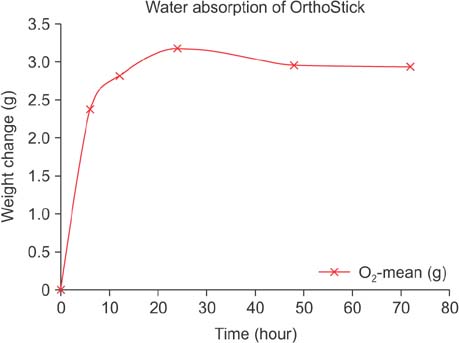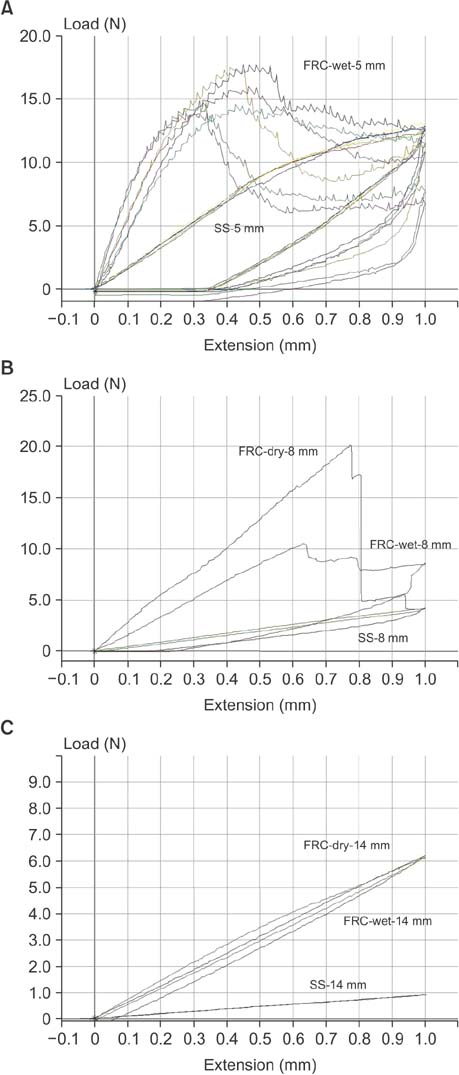Korean J Orthod.
2018 Mar;48(2):107-112. 10.4041/kjod.2018.48.2.107.
Comparison between fiber-reinforced polymers and stainless steel orthodontic retainers
- Affiliations
-
- 1Department of Orthodontics, Vita Salute San Raffaele University, Milano, Italy. lucchese.alessandra@hsr.it
- 2Unit of Dentistry, Division of Orthodontics, Research Area in Dentofacial Orthopedics and Orthodontics, IRCCS San Raffaele Scientific Institute, Milano, Italy.
- 3Unit of Dentistry, Vita Salute San Raffaele University, Milano, Italy.
- 4Research Area in Oral Pathology and Implantology, IRCCS San Raffaele Hospital, Milan, Italy.
- 5Department of Orthodontics, Seconda Università degli Studi di Napoli, Caserta, Italy.
- KMID: 2406819
- DOI: http://doi.org/10.4041/kjod.2018.48.2.107
Abstract
OBJECTIVE
The aim of this study was to examine the properties of fiber-reinforced composite and stainless steel twisted retainers for orthodontic retention.
METHODS
Three different span lengths (5.0, 8.0, and 14.0 mm) of fiber-reinforced composite were investigated. The three fiber-reinforced composite retainer groups were subdivided according to the storage condition (dry and wet), resulting in a total of six groups. Each stainless steel and fiber-reinforced composite group was comprised of six specimens. The three-point bending flexural test was conducted using a universal testing machine. ANOVA was used to assess differences in the maximum load and maximum stress according to the span length, material, and storage condition. Post-hoc comparisons were performed if necessary.
RESULTS
The maximum stress and maximum load were significantly (p < 0.001) associated with the span length, material, and storage condition. The significant interaction between the material and span length (p < 0.001) indicated the differential effects of the material for each span length on the maximum stress and maximum load, with the difference between materials being the highest for the maximum span length.
CONCLUSIONS
Our findings suggest that fiber-reinforced composite retainers may be an effective alternative for orthodontic retention in patients with esthetic concerns or allergy to conventional stainless steel wires.
MeSH Terms
Figure
Reference
-
1. Littlewood SJ, Millett DT, Doubleday B, Bearn DR, Worthington HV. Retention procedures for stabilising tooth position after treatment with orthodontic braces. Cochrane Database Syst Rev. 2016; (1):CD002283.
Article2. Al Yami EA, Kuijpers-Jagtman AM, van't Hof MA. Stability of orthodontic treatment outcome: follow-up until 10 years postretention. Am J Orthod Dentofacial Orthop. 1999; 115:300–304.
Article3. Dahl EH, Zachrisson BU. Long-term experience with direct-bonded lingual retainers. J Clin Orthod. 1991; 25:619–630.4. Lucchese A, Gherlone E, Portelli M, Bertossi D. Tooth orthodontic movement after maxillofacial surgery. Eur J Inflamm. 2012; 10:227–231.
Article5. Portelli M, Matarese G, Militi A, Logiudice G, Nucera R, Lucchese A. Temporomandibular joint involvement in a cohort of patients with juvenile idiopatic arthritis and evaluation of the effect induced by functional orthodontic appliance: clinical and radiographic investigation. Eur J Paediatr Dent. 2014; 15:63–66.6. Lucchese A, Carinci F, Brunelli G, Monguzzi R. An in vitro study of resistance to corrosion in brazed and laser-welded orthodontic appliances. Eur J Inflamm. 2011; 9:67–72.7. Ardeshna AP. Clinical evaluation of fiber-reinforced-plastic bonded orthodontic retainers. Am J Orthod Dentofacial Orthop. 2011; 139:761–767.
Article8. Goldberg AJ, Burstone CJ. The use of continuous fiber reinforcement in dentistry. Dent Mater. 1992; 8:197–202.
Article9. Freilich MA, Meiers JC, Duncan JP, Goldberg AJ. Fiber-reinforced composites in clinical dentistry. Chicago: Quintessence Publishing;1999. p. 18–46.10. Burstone CJ, Kuhlberg AJ. Fiber-reinforced composite in orthodontics. J Clin Orthod. 2000; 34:271–279.11. Lucchese A, Manuelli M, Bassani L, Albertini P, Matarese G, Perillo L, et al. Fiber reinforced composites orthodontic retainers. Minerva Stomatol. 2015; 64:323–333.12. Lastumäki TM, Kallio TT, Vallittu PK. The bond strength of light-curing composite resin to finally polymerized and aged glass fiber-reinforced composite substrate. Biomaterials. 2002; 23:4533–4539.
Article13. Göhring TN, Gallo L, Lüthy H. Effect of water storage, thermocycling, the incorporation and site of placement of glass-fibers on the flexural strength of veneering composite. Dent Mater. 2005; 21:761–772.
Article14. Garoushi S, Lassila LV, Vallittu PK. The effect of span length of flexural testing on properties of short fiber reinforced composite. J Mater Sci Mater Med. 2012; 23:325–328.
Article15. Rucker BK, Kusy RP. Elastic flexural properties of multistranded stainless steel versus conventional nickel titanium archwires. Angle Orthod. 2002; 72:302–309.16. Tezvergil A, Lassila LV, Vallittu PK. Strength of adhesive-bonded fiber-reinforced composites to enamel and dentin substrates. J Adhes Dent. 2003; 5:301–311.17. Van Meerbeek B, Perdigão J, Lambrechts P, Vanherle G. The clinical performance of adhesives. J Dent. 1998; 26:1–20.
Article18. Roncati M, Lucchese A, Carinci F. Non-surgical treatment of peri-implantitis with the adjunctive use of an 810-nm diode laser. J Indian Soc Periodontol. 2013; 17:812–815.
Article19. Lucchese A, Carinci F, Saggese V, Lauritano D. Immediate loading versus traditional approach in functional implantology. Eur J Inflamm. 2012; 10:55–58.20. Bearn DR, McCabe JF, Gordon PH, Aird JC. Bonded orthodontic retainers: the wire-composite interface. Am J Orthod Dentofacial Orthop. 1997; 111:67–74.
Article21. Baysal A, Uysal T, Gul N, Alan MB, Ramoglu SI. Comparison of three different orthodontic wires for bonded lingual retainer fabrication. Korean J Orthod. 2012; 42:39–46.
Article22. Bryan DC, Sherriff M. An in vitro comparison between a bonded retainer system and a directly bonded flexible spiral wire retainer. Eur J Orthod. 1995; 17:143–151.
Article23. Lucchese A, Bertacci A, Chersoni S, Portelli M. Primary enamel permeability: a SEM evaluation in vivo. Eur J Paediatr Dent. 2012; 13:231–235.24. Prati C, Chersoni S, Lucchese A, Pashley DH, Mongiorgi R. Dentin permeability after toothbrushing with different toothpastes. Am J Dent. 1999; 12:190–193.
- Full Text Links
- Actions
-
Cited
- CITED
-
- Close
- Share
- Similar articles
-
- Comparison of the fatigue limit of fiber-reinforced composites and stainless steel wires when attached to the tooth surface for anchorage reinforcement
- Comparison of frictional forces between orthodontic brackets and archwires
- The study of tension characteristics in orthodontic wires
- Fatigue resistance, debonding force, and failure type of fiber-reinforced composite, polyethylene ribbon-reinforced, and braided stainless steel wire lingual retainers in vitro
- Evaluation of frictional forces between orthodontic brackets and archwires



